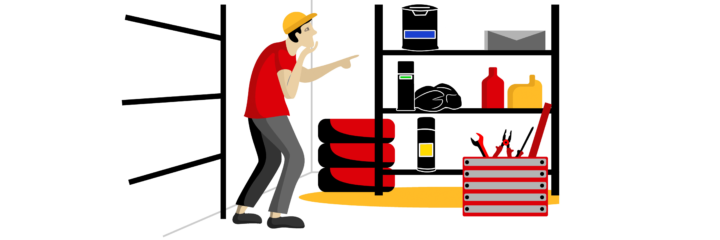If you’re a big car lover, it makes sense to want your ride to stand out from the crowd. Adding designs, accessories, and other peripherals to customize your vehicle can be rewarding as a car owner, but all the little expenses can add up in the long run.
A low-cost way to personalize your car is to paint your brake calipers with specialized paints. Although caliper paints will cost slightly higher than regular cans of spray paint, they’re a worthy investment to make down the road.
Finding the best brake caliper paint is crucial if you want to tackle a project like this successfully. But how are you to find your perfect match out there? Well, if that question has been burning in your mind, then you’re in the right place – this article will discuss everything you need to know about caliper paints, including a list of the best brake caliper paints you can find in the market right now.
- Factors to Consider When Buying Caliper Paints
- Top 7 Best Caliper Paints 2026
- 1. Best Overall Pick: POR-15 Caliper Paint
- 2. Best Premium Pick: G2 High-Temperature Brake Caliper Paint System
- 3. Best Budget Pick: VHT Brake Caliper Paint Can
- 4. Easiest to Apply: Dupli-Color Brake Caliper Paint
- 5. Best for Precision Spraying: Rust-Oleum Caliper Spray Paint
- 6. Most Versatile Caliper Paint: Superwrap Sprayable Vinyl Wrap
- 7. Best Long-Lasting Pick: Eastwood Long Lasting Heat Resistant Caliper Paint
- Full Guide to Buying Caliper Paints
- Final Words
Factors to Consider When Buying Caliper Paints
Before we proceed to the list of best caliper paints you can buy online, here are some of the most important factors you should consider first.
Type
Not all caliper paints are made the same. This may be somewhat of a no-brainer, but paint type is something you should consider when looking for the perfect caliper paint for your needs.
Type usually refers to the material that the paint product is made of. It can be epoxy, enamel, or even vinyl film. The important thing to remember is that they all have their own pros and cons. For instance, epoxy paints can withstand temperature a lot better than either vinyl or enamel.
There’s a whole lot more to this; if you want to know more details, head over to our full buyer’s guide below.
Color
When you’re painting your car to personalize it, it’s only natural to want a long-lasting, beautiful color that perfectly matches your personality.
Therefore, one important factor to consider when picking caliper paints is the paint color. Different brands are going to offer different colors. For example, G2 Caliper Paint System has 11 colors in its arsenal, while Rust-Oleum gives you only 4 choices. You should always check beforehand whether the product you want offers the color that you prefer.
More than the color spectrum, it’s also essential to know what the finish quality is of the product you’re going to buy. Will the finished product be rough or smooth? Matte or gloss? Knowing these things in advance helps bring out the best of what your chosen caliper paint has to offer.
Size
In general, one aerosol can of canister paint can cover all four of a car’s calipers and still have a little bit of material left. However, if you wish to purchase in bulk, there are always combo packs available. These bundles are cheaper overall than their price per piece.
A general rule to abide by is to purchase at least two cans of aerosol paint if painting standard-sized vehicle calipers. If you run out, you won’t have to wait long for the next coating, making for a better paint job.
However, if your brake calipers are a lot larger than the size of a clenched fist, then you’re going to need more paint.
Resistance
Your brake calipers are some of the most exposed parts of your vehicle. They regularly come into contact with water, chemicals, and debris on a day-to-day basis, not to mention the extreme friction that they generate to serve their purpose. High-temperature resistance will assure you that all your time and effort will not peel off after several drives.
You’d also want to check other related properties, such as resistance to scratching, chipping, chemicals, and corrosion. Aside from being aesthetically pleasing, caliper paints are also meant to protect the surface of your brake caliper from these damaging factors. The more resistant your caliper paint is to external factors, the longer-lasting your paint job will be.
Application Method
There’s a lot more to be said about the application method later on in this guide, but let’s highlight the very basics.
Caliper paints are generally sold in two kinds: dip-brush application type and aerosol sprays. Beginners are more likely to prefer brush application compared to aerosol sprays. Although sprays are convenient, it’s very easy to make off-sprays and waste a lot of material. With brush application, one can carefully apply the paint with less chance for wastage.
Drying Time
Drying time is one of the most useful things to know about your chosen caliper paint. You don’t want to be uncertain about the time that your coat takes to dry. If you don’t know how long the paint dries, you may fail to schedule your time to get the job done properly. Worse, you might end up invalidating all your hard work by using your calipers before the paint has fully cured.
High-quality caliper paints should be performance-dry about two hours after application. Your product should only need a minute or two before it’s dry enough to coat with another layer.
Coverage
The best caliper paint should be able to complete a full application within two or three coats. This refers to the base layer plus the full-coverage finish layer. If you need to apply any more to achieve a quality finish, you’re not getting the quality you deserve. This is all the more important for paint-application cans where the substance is more likely to be concentrated.
Durability
The best caliper paint should last for at least several years. Nobody wants to retouch their brake caliper every few months. Choose a product that is essentially something you can paint on and forget until the next painting session 5 years down the road.
Now that you know the factors you need to consider when buying caliper paints, it’s time to get to the products themselves. Without further ado, here are the 7 best caliper paints that you can buy online right now.
| Product | Colors Available | Type | Application Method | Heat Resistance | Drying Time | Rating |
|---|---|---|---|---|---|---|
| POR-15 Caliper Paint | 5 | Dipping Can, Heat Resistant | Dip, Brush | 500°F | 3-4 Hours Coat Drying Time, 24 Hours Full Curing Time | 5 |
| G2 High-Temperature Brake Caliper Paint System | 11, Including Black, Blue, and Red | Hardens; Rust-Resistant | Brush | 980°F | 1-1.5 Hours Drying Time, 12 hours Curing Time | 5 |
| VHT Brake Caliper Paint Can | 9, Including Black, Blue, and Red | Glossy | Spray | 500°F | 30 Mins Touch-Dry, 24 Hours Curing Time | 4.5 |
| Dupli-Color Brake Caliper Paint | 6, Including Black, Blue, and Red | Ceramic-Based Resin | Spray | 500°F | 30 Minutes Drying Time | 4.5 |
| Rust-Oleum Caliper Spray Paint | 3, Including Black | N/A | Spray | 900°F | 24 Hours Curing Time | 4 |
| Superwrap Sprayable Vinyl Wrap | 5 | Sprayable Vinyl | Spray | 500°F | 30 Minutes | 4 |
| Eastwood Long Lasting Heat Resistant Caliper Paint | 3 | Spray Paint | Brush or Spray | 650°F | 1 Hour Dry to Touch | 3.5 |
Top 7 Best Caliper Paints 2026
1. Best Overall Pick: POR-15 Caliper Paint
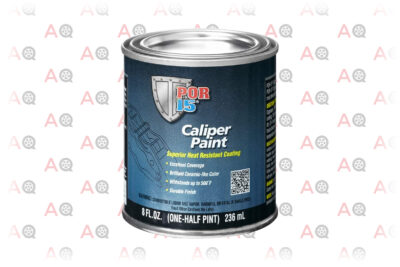
Editor’s Rating:
Quick Facts
- Colors Available: 5
- Type: Dipping Can, Heat Resistant
- Application Method: Dip, Brush
- Heat Resistance: 500°F
- Drying Time: 3-4 Hours Coat Drying Time, 24 Hours Full Curing Time
Features
POR-15 certainly doesn’t hold back anything in their pursuit to give their customers top-of-the-line products, and this specialized caliper paint is a great example of that.
The POR-15 Caliper Paint is designed specifically to withstand high-temperature operations. It provides a long-lasting coating to protect against heat and various elements, boasting resistance to heat measuring up to 500°F. It also comes in different ceramic shades to make your car uniquely yours at the same time.
Overall Performance
Everything about POR-15 screams convenience and quality. The paint is sold in an 8-ounce can, more than enough to cover a standard-sized brake caliper. It comes in five beautiful and shiny vintage-like colors. The coat cures into a ceramic-like, durable finish that can protect your brake calipers from damaging factors like metal oxidation, although it can’t really do much for scratches and scrapes.
It’s formulated for brake calipers, but you can also apply it as a protective coating on other small, metallic parts of your vehicle, making it quite versatile. That said, while the paint can withstand a punishing 500°F peak, it actually pales in comparison to the competition, some of which can withstand over 900°F like G2’s High-Temperature Brake Caliper Paint System and Rust-Oleum’s Caliper Spray Paint.
The application is incredibly straightforward albeit a little messy. If you want to dip-apply it for a more convenient time, you’re going to have to remove your brake calipers from your vehicle first. If this doesn’t seem doable for you, you can always opt to hand-paint it instead. However, be prepared to devote a little more time to finish the task and accept that there will be spots that cannot be reached by your paintbrush.
Nevertheless, the POR-15 Caliper Paint is a good all-around choice for anyone looking to personalize and protect their brake calipers simultaneously.
Pro-Tip
POR-15 sells this caliper paint in a three-step paint system. Pair it with POR-15’s cleaner/degreaser and metal prep rust neutralizing agent for best results.
Pros
- Tough and durable coating
- Comes in 5 ceramic-like colors
- Protects against metal oxidation
Cons
- 500°F heat resistance is lacking
- Brush application doesn’t give full coverage
- Does not protect against scratches and scrapes
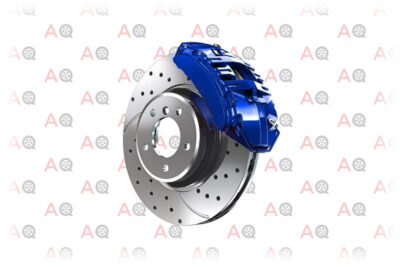
Editor’s Rating:
Quick Facts
- Colors Available: 11, Including Black, Blue, and Red
- Type: Hardens; Rust-Resistant
- Application Method: Brush
- Heat Resistance: 980°F
- Drying Time: 1-1.5 Hours Drying Time, 12 hours Curing Time
Features
G2’s High-Temperature Brake Caliper Paint System is a specialized caliper paint system that prides itself on having the highest temperature tolerance in the market right now. It can withstand temperatures of up to a whopping 980°F, almost double the resistance of other products like POR-15’s Caliper Paint.
In addition to this, the paint hardens to a chip, flake, and rust-resistant coating that can be painted on for further customization.
Overall Performance
Sold as a full kit, this High-Temperature Caliper Paint System comes complete with the paint, brake cleaner, brake caliper reactor, and brush. It offers one of the highest heat resistance in the market, so you can be assured that the heat generated by your driving will not pose a problem in keeping your brake calipers looking good.
The paint sticks very well to the surface metal, and the color doesn’t easily fade or wear off. It’s designed to resist damage from road salt, water, chemicals, and small debris. It becomes harder than aerosol sprays when dried, which means it will not flake or get chipped.
It also dries faster compared to the competition, and one coating of paint can already get you far. You can easily do three coatings of paint on four standard-sized brake calipers, and you’ll still have a little bit of something left over.
As good as the product is, though, the brush that comes with the set isn’t very user-friendly. It’s hard to aim precisely, and sometimes, it even leaves bristle marks on the still-wet paint. You should also be mindful when using this paint as it coagulates easily at room temperature. This can result in an uneven finish that doesn’t look as good.
Pro-Tip
Coagulation, also known as clumping or clotting, occurs in this paint when the surrounding temperature is higher than around 72°F, or room temperature. If possible, schedule your painting season during colder weather to lessen the chances of this happening. Also, make sure to stir the paint every now and then while using it.
Pros
- Hardens to a shiny coating
- Impressive 980°F heat resistance
- Protects against chemical and physical damages
- The set already has everything you need
- Offers 11 color choices
Cons
- Clumps very easily
- More expensive than the competition
- Marketed colors don't always match real life
3. Best Budget Pick: VHT Brake Caliper Paint Can
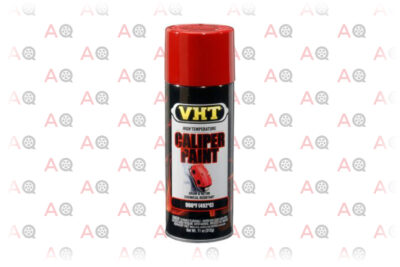
Editor’s Rating:
Quick Facts
- Colors Available: 9, Including Black, Blue, and Red
- Type: Glossy
- Application Method: Spray
- Heat Resistance: 500°F
- Drying Time: 30 Mins Touch-Dry, 24 Hours Curing Time
Features
If you’re looking for a brake caliper paint that can fit even into the tightest of budgets, look no further than VHT’s High-Temperature Brake Caliper Paint.
It’s formulated specifically for brakes, rotors, brakes, drums, and calipers. It dries into a sturdy, heat-resistant coat that can also resist chemicals and rust. The coat is also sturdy enough to resist regular wear and tear, scratches, peels, and chips.
Overall Performance
Considering the low price, the VHT Caliper Paint performs wonderfully even in extreme conditions.
The paint atomizes well and produces a good, solid, and even coverage. It dries to the touch very quickly, but you need to let it undergo the complete overnight curing process before using your vehicle. Once fully cured, it can survive temperatures of up to 900°F.
Application is very convenient, as it comes in an aerosol spray can with a quality nozzle that is easy to use even for beginners. There are also product instructions present on the can that you can follow if it’s your first time painting your brake calipers.
The color variety is diverse enough for everyone and shines well in bright sunlight after a correct application. You can choose colors that are not commonly available in other caliper paints, such as gold, orange, and glossy black.
However, you do need to be careful when using this product, as it can be quite choosy when it comes to adhering to your calipers. One, it’s not as thick as other caliper paints, so the application can be more difficult and messier than other paints. Two, you need to use a clear finishing coat to prevent brake dust from dulling the paint’s vibrant color. As long as you do this, we guarantee that the results won’t disappoint you.
Pro-Tip
This caliper paint actually belongs to the VHT paint system. You can get the highest quality results when used in conjunction with the VHS cleaner and paint finish. Complete curing can occur even at room temperature, but you can also heat your brake calipers to 200°F to speed up the process.
Pros
- Wide color variety
- Lower price when bought as a six-pack
- Can help resist rust as well
- Resistance to high temperatures
- Protects against harmful chemicals
Cons
- Actual colors are a bit off from the packaging
- Color can fade out over time if not properly sealed
- Other products needed for best results
4. Easiest to Apply: Dupli-Color Brake Caliper Paint
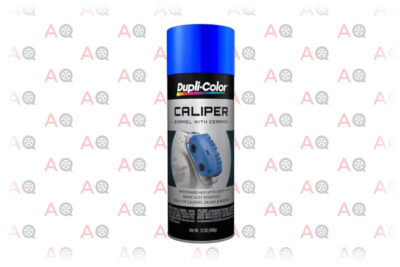
Editor’s Rating:
Quick Facts
- Colors Available: 6, Including Black, Blue, and Red
- Type: Ceramic-Based Resin
- Application Method: Spray
- Heat Resistance: 500°F
- Drying Time: 30 Minutes Drying Time
Features
Thanks to its special “EZ Touch” Conical Nozzle, painting your brake calipers is made much easier with Dupli-Color’s brake Caliper Paint.
Once it dries, it hardens into a sturdy coating that not only looks good but also protects your calipers against brake dust, chipping, and automotive and road chemicals. Not to mention, because of the ceramic resin materials, the glossy coating can withstand the heat of up to 500°F. All of this from a simple point-and-spray can.
Overall Performance
If you’re looking for a product that can protect your brake calipers in all aspects, then you’re in the right place. The paint can withstand up to 500°F of heat, and once fully cured, it can also resist minor damages such as chipping and abrasions. It can also prevent your calipers from developing rust and corrosion. A versatile product, you can apply it to drums and brake rotors as well.
Dupli-Color’s Caliper Paint is also rather convenient to use. Its special feature, the “EZ Touch” technology, ensures you will not waste an atom of spray when you point and press this product towards your calipers. You can expect the paint to dry in just 30 minutes, although you need to wait at least an hour for it to fully dry.
It can be bought in single, 2-pack, or 6-pack choices, each one providing you with the formula to a beautiful, long-lasting caliper brake finish. It also comes as a Paint Kit – a complete set containing the paint, aerosol cleaner, stick for stirring, paintbrush, masking tape, and even an instruction booklet to help you if it’s your first time undertaking a project like this.
Be warned – the finished product is more matte than glossy, despite what Dupli-Color is actually advertising. However, for people looking for that exact look, this should be no problem at all.
Pro-Tip
For the best results, consider using the Paint Kit mentioned above, which has everything that you will need to ensure a successful, high-quality, and long-lasting finish. If you don’t want to buy the full kit, however, Dupli-Color also sells a cleaner individually.
Pros
- Attractive matte finish
- Fast drying time
- Chip, chemical, and dust resistant
- Includes a detailed instruction manual
Cons
- Lower heat resistance than the competition
- Advertised as glossy instead of matte
5. Best for Precision Spraying: Rust-Oleum Caliper Spray Paint

Editor’s Rating:
Quick Facts
- Colors Available: 3, Including Black
- Type: N/A
- Application Method: Spray
- Heat Resistance: 900°F
- Drying Time: 24 Hours Curing Time
Features
Rust-Oleum has been a huge name in the rust inhibition industry for quite a long time now, and deservedly so. The company now brings its reputation of providing top-of-the-line rust-inhibiting chemicals into the caliper painting market with this new product.
The Rust-Oleum Caliper Spray Paint dries into a strong, durable coating that can resist temperatures of up to 900°F. Aside from brake calipers, the paint can also be applied to springs, rotors, and drums.
Overall Performance
Performance-wise, this caliper spray paint is perfect for day to day driving, especially for hot climates and even for competitive driving. It’s also designed to resist rusting due to moisture, chemicals, or brake dust deposits, so you can rest assured that your calipers remain safe and sound beneath this protective layer of paint.
In addition to this, Rust-Oleum’s easy-spray technology makes it easy for anyone to touch up their brake calipers. The comfort-tip nozzle works from any angle so that you can reach even the most body-twistingly difficult places.
The biggest downside to this product is the coverage, specifically the sheerness of it. Each can contains 12 ounces of material, but since the coverage isn’t that good, you would have to do at least two coats to fully cover your calipers. At most, a single can only covers two full coatings on two brake calipers, which makes it relatively expensive compared to other options on the market. It also doesn’t dry that fast, which means you’ll be spending a lot of time painting with this product.
Pro-Tip
Although the paint instructions on the container tell you that you don’t have to prime, this doesn’t mean that you can’t—or that you shouldn’t. Users have reported better success if they prime the metal first before applying this spray. Other than this, Rust-Oleum’s paint is also safe to dry with microwave ovens or hair dryers, in case the weather outside is too cloudy or rainy to dry paint well.
Pros
- Easier spraying with comfort-tip nozzle
- Resists heat up to 900°F
- Has rust-inhibiting features
- Scratch, peel, and chip-resistant
Cons
- Requires multiple coats for the best finish
- Long drying time
- Not resistant to brake cleaner agents
6. Most Versatile Caliper Paint: Superwrap Sprayable Vinyl Wrap

Editor’s Rating:
Quick Facts
- Colors Available: 5
- Type: Sprayable Vinyl
- Application Method: Spray
- Heat Resistance: 500°F
- Drying Time: 30 Minutes
The Superwrap is a new product with lots to prove. With its high-end look and easy application, it’s a perfect choice for beginner DIY-ers who are not confident yet with their painting skills.
You can use Superwrap for your wheels and accessories, including your car’s brake calipers. The best thing about this product is that it only takes a single step to get a good-looking finish.
Since it’s a sprayable vinyl, you can easily peel it off with a scraper if you want to remove it. It does come with fewer benefits than traditional spray paints, but its one-step, easy application makes it worth considering for many.
Overall Performance
The Superwrap can give your brake calipers a high-gloss, professional, premium look that is hard to beat, especially for the amount of effort–or lack thereof–that it takes to do.
Although it’s very different from traditional spray paint, the process is fairly similar. This includes cleaning, masking, spraying, and drying out. One remarkable thing about this product is the fact that it’s made out of vinyl. This means that you can peel it off much easier than normal paint in case you change your mind. Otherwise, it stays strongly bonded to the material.
Performance-wise, the material is self-leveling and does not drip while drying. If you do it properly, meaning while the paint is still half-dry, you can remove the tape without peeling any part of the paint off.
Just make sure to follow the instructions to the letter and apply it during good weather for proper drying. If you do this, you’re sure to have great-looking brake calipers to spruce up your car’s looks.
However, since the product is more for detailing and aesthetics, it does fall slightly short in the protection aspect. Although it looks good, all it has is a bit of heat resistance – no protection against physical, chemical, and corrosion damage whatsoever.
Pro-Tip
The Superwrap was not originally manufactured for brake calipers, which means that you can use it on any metal surface of your car, not just your calipers.
Be sure to apply the product in multiple light coats until you achieve the desired effect. After doing so, lock in the color by using a paint sealant to reduce the chances of it peeling and chipping away.
Pros
- Extremely easy to apply
- Professional-looking finish
- Does not drip while drying
- Easy to remove
Cons
- No additional protective qualities
- Durability is doubtful in some instances
- New product means fewer user reviews
7. Best Long-Lasting Pick: Eastwood Long Lasting Heat Resistant Caliper Paint
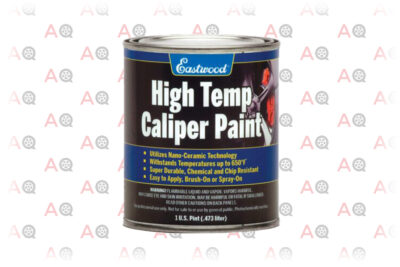
Editor’s Rating:
Quick Facts
- Colors Available: 3
- Type: Spray Paint
- Application Method: Brush or Spray
- Heat Resistance: 650°F
- Drying Time: 1 Hour Dry to Touch
Eastwood’s offering may be relatively new on the market, but its take on brake caliper paint is spot-on. This paint is highly resistant to heat, chemicals, and UV rays. It’s also wonderfully convenient to apply, as you don’t have to remove your brake caliper from your car to paint it. Moreover, you can either spray it or brush it with a paintbrush, which is quite rare for caliper paints, as far as we’re concerned.
Overall Performance
Eastwood has developed a reliable reputation in the repair and restoration automotive paints industry, although they’re not as well-known in this specific niche. This product, which comes in silver, red, and black, is their entry into the caliper brake market.
Because of its nano-ceramic technology, it’s able to withstand up to 650°F of heat. It can even protect against the harmful and corrosive effects of chemicals and UV rays as well. You can apply it via brush, roll, or paint gun. The paint comes in a large 16-ounce can, which means one is enough for four brake calipers. Thankfully, it can go a long way in terms of coverage.
Once you’ve applied it and properly sealed it, you can rest assured of brand-new looking calipers that wouldn’t accumulate brake dust. The self-sealing nature of the paint allows it to dry to a hard coating, which makes for easy cleaning.
However, one particular drawback is the cost of the maximum-quality kit, since you need to buy several more products individually to achieve the best effects.
Pro-Tip
To get the best out of Eastwood’s Heat Resistant Caliper Paint, you should use the urethane activator. It cures and hardens the ceramic and urethane components of the paints, allowing the paint to become even sturdier.
You should also buy the pre-painting aerosol spray to achieve the most optimal cleanliness for the highest quality finish. The cleaner the surface, the better the final look.
Pros
- Resistant to UV and chemicals
- Above-average heat resistance
- Convenient spray or brush application
- Long-lasting
- Large can means more coverage
Cons
- Limited color choices
- Produces strong fumes
- Can cause skin irritation
Full Guide to Buying Caliper Paints
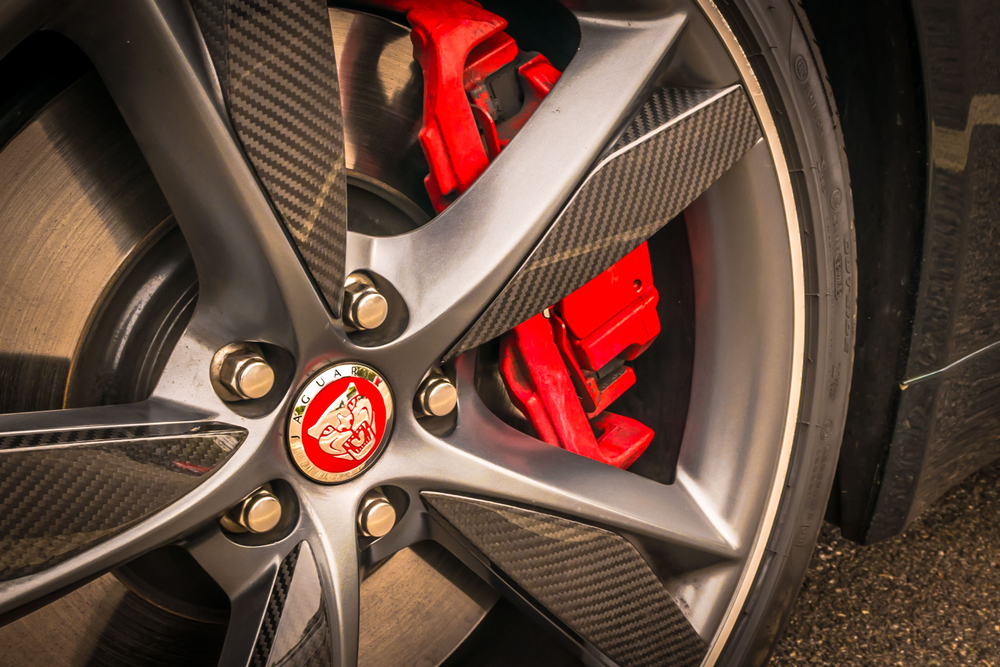
Interested in knowing more? This section will cover everything you need to know about caliper paints, including what they are, what are their advantages, and how to apply them to your vehicle.
What Are Caliper Paints?
Caliper paints are paint products formulated specifically for brake calipers. The brake calipers of your car are an important part of your vehicle’s braking function, which includes disc brakes for the front and back wheels. Calipers house the brake pads, which are two pieces of metal that create friction with the rotating disk of your wheel to slow your vehicle down every time you hit the brakes.
Although there are various methods for upgrading your vehicle’s look, painting your brake calipers is probably one of the most affordable yet most overlooked.
With caliper paints, you get to add a dash of oomph to your ride without having to do costly overhauls. It also serves to protect the metal surface of the brake calipers from external factors, such as moisture, chemicals, and friction. Thus, it’s important to choose the best caliper paints to ensure the best for your car.
Benefits of Using Caliper Paints
At this point, you may be wondering if you even need to paint your calipers in the first place. Short answer? Yes. Here are some of the main benefits of using caliper paints.
1. It Adds to the Aesthetic of Your Vehicle
Tired of your ride’s same old look, but can’t commit to anything too time-consuming or expensive?
Painting your calipers lets you add a dash of style to your vehicle without all of the hassles and cost that comes with a full design modification. You can even choose different colors to complement the look that you’re aiming for, and it easily accentuates the design of your vehicle. Make your car pop with just a little touch-up!
2. It Offers Tremendous Benefits for Low Costs
Vehicle upgrades will undoubtedly cost you thousands of your hard-earned cash. Painting your brake calipers alone may not provide as much impact as fully repainting your car, but it’s always better than your vehicle remaining its drab self. Best of all, this nifty little upgrade won’t even put a dent in your pocket.
3. Provides Additional Protection for Your Calipers
The best-quality caliper paint shouldn’t only make your vehicle look good; it should also be durable.
Think about it. Your vehicle’s brake system is regularly subjected to high temperatures and constantly exposed to debris, road chemicals, and water. Due to this, calipers are more prone to corrosion, rust, and damage. A good coat of protective paint can help mitigate these damages and therefore keep your car safe and sound for longer.
4. Painting Your Brake Calipers Is Not Rocket Science
It’s barely even mechanical science. All you have to know is how to remove your tires and wheels. The rest of the process is as easy as one, two, three. If you know how to follow basic instructions–like the ones included in this guide below – then you’ve got all you need to perfectly pull off the job.
5. You Can Redo It Anytime You Want
Since painting your brake calipers is not a major design modification, it’s very easy to redo it if you’re unhappy with how it turned out. Just buy another can or two of your desired color and dedicate a few hours to finish the process, and you can say hello to your car’s new look.
Types of Caliper Paints
There are several types of caliper paints, each with their own pros and cons.
Aerosol
Also known as spray paints, aerosol paints are some of the most common types of caliper paints on the market right now. They typically contain enamel-based paint and are commonly sold in 11- or 12-ounce cans, with a wide variety of gloss, metallic, matte, or other kinds of finish.
This kind of paint is popular thanks to its ease of application and relatively quick drying time. However, they tend to need a few coats of material to provide a finished look, meaning you have to factor in multiple coats when estimating your total application time.
Vinyl Film
Vinyl film is a more difficult type of caliper paint to work with, especially if you’re a complete beginner. That’s because you need tools, such as razor blades and heat guns, to pull off the job successfully. In return though, you get a much faster drying time and a cleaner finish.
The paint comes in vinyl sheets and, using a heat gun, you’ll have to meld the sheet to the surface of your brake calipers, completing the process in one step. If there’s any excess film visible at the edges, simply trim it with your razor.
Dipping Cans
Dipping cans are a nice option to have for people who find brush painting or spray painting inconvenient. With dipping cans, you simply have to dip your calipers into the can of paint, resulting in a uniform coat with only one application.
The only notable downside is that you have to completely remove your brake calipers from your vehicle first – something that you don’t necessarily have to do when using vinyl film or aerosol paints.
Epoxy
Epoxy-based caliper paints adhere to the metal of your calipers much better than any other type on this list. They’re durable and protective, and they keep your brake calipers looking good for a long time to boot.
Unfortunately, not only are they more volatile than other caliper paint chemicals, but they’re also more difficult to apply. Plus, all the caustic chemicals present in the paint could seriously harm you, so you need to take more safety precautions before you begin the painting process.
Important Features of Caliper Paints
Different products offer different things. To find the best caliper paint for your vehicle, you should take note of the features that these products usually offer.
Paint Density
The denser the paint is, the more effective it is in protecting the metal surface of your caliper against the elements that it gets exposed to every day. It can also better inhibit rust and other forms of corrosion from forming on your calipers.
However, keep in mind that a higher paint density also equates to a muddier finish, so you have to find the middle ground if you want to create a shinier coat.
For instance, polymer-based paints, a dense type of paint, result in a thick enamel coating that can protect your calipers from chemical, physical, and even temperature damage while creating a beautiful and shiny finish.
Resistance to Different Elements
As mentioned, caliper paints don’t exist purely for the sake of design. They also have to be functional. Caliper paints are a great way to protect your brake calipers from damage, be it from road chemicals, debris, or water.
To know what you can expect from your caliper paint, it’s good to know the kind of resistance that they can offer you first.
Heat Resistance
Since they regularly deal with a lot of friction, it’s normal for your vehicle’s brakes to become hot during daily use.
A temperature spike of above 400°F (204°C) is a normal occurrence for these components, and they can sometimes even rise higher than the vehicle’s engine itself. Because of this, normal paint will undoubtedly burn off, and you’ll be left with exposed and vulnerable brake calipers.
Heat-resistant paints like specialized caliper paints, on the other hand, work as fire inhibitors that expand above a certain temperature threshold to provide a barrier for insulation.
Rust Resistance
Rust resistance is another important aspect of caliper paints. Rust-inhibiting formulas prevent oxidation to happen on the metal’s surface. Oxidation happens when metal reacts negatively to water and oxygen, allowing corrosion to occur.
To prevent it, your caliper paint should adhere strongly to the metal surface and seal tightly enough to completely cut off its exposure to air. For double protection, other rust-inhibiting paints have zinc additives, which oxidize themselves to protect the metal underneath.
Chemical Resistance
You may not notice it, but your brake calipers are exposed to tons of chemicals every day. Various metal-damaging chemicals are present in the asphalt of your roads, such as road salts and harmful oils.
You may not be driving across a chemical, radioactive wasteland when you drive to work, but little by little, these trace amounts of chemicals can accumulate and eventually cause damages to your calipers.
Chemical resistant caliper paints can prevent this by providing a neutral buffer between the underlying metal surface and the outside world.
Damage Resistance
You shouldn’t expect bulletproof resistance, but a good caliper paint should at least be strong enough to resist abrasions, scratches, and chips. More than protecting the metal surface, high-quality caliper paints are actually damage resistant themselves. This allows them to stay on your calipers and look good even after months or years.
Brush vs. Spray
There are different ways that you can apply your caliper paints, but by far the two most common methods are by brush or by aerosol spray.
Pros and Cons of Brushing
Brush-type applications are best for you if you want precision and control. The paint must be dense and adherent, as you want the paint to stick to the brush after just one dip. If it doesn’t, then that means it’s too watery and perhaps not ideal for brushing.
Because these paints tend to run thicker than aerosol sprays, you typically don’t need to do more than one coating, two max. This is different from aerosol sprays whose coverage is on the thinner side, so you have to go through the extra coating to have an adequate finish.
However, if you don’t do it well, your brush strokes can leave uneven and undesirable streaks on your calipers. Companies also tend to pack cheap paintbrushes in brush kits, leaving paint bristles on your work that results in an uneven texture.
Pros and Cons of Spraying
If your main consideration is the ease of application, then aerosol spray paints are the way to go. All you have to do is point and press. They also tend to result in a more balanced final layer.
In addition to this, you have the added benefit of being able to reach nooks and crannies that may otherwise be rendered inaccessible by brushing. You don’t have to remove the calipers themselves, just the wheel. To prevent paint from getting into undesirable areas, simply use tape to mask them.
However, although sprays are convenient, you have less control over the output of your work, as you can’t adjust the sensitivity of the spray or the size of the nozzle. Also, if you’re painting in an uncontrolled environment–say, outdoors on a windy day–aerosols can definitely make the application a lot messier than necessary.
Steps to Painting Your Calipers
Before painting, make sure that you have the following materials prepared.
- Your chosen caliper paint
- Rubbing alcohol
- Masking tape
- Degreaser
- Rag for cleaning
- Sandpaper with a 400-600 grit
- Tools for wheel removal
- Protective equipment, such as gloves and workshop goggles
- Hydraulic jack, or any form of load-bearing elevation for your vehicle
Painting your brake calipers is actually an easy, straightforward job, but it can be quite overwhelming for someone who has never done it before.
- Mount your vehicle to allow you to remove the wheels. You can also choose to remove your calipers and set them down on a flat surface.
- Clean the surface that you want to paint with a rag.
- Next, sand down the whole area with 400-600 grain sandpaper to grind down rust and create a rough enough surface for the paint to stick on.
- Apply a degreaser before wiping it again with rubbing alcohol to ensure that no unwanted particles are remaining.
- Mask the areas that you don’t want to paint using painter’s tape or masking tape. Make sure you cover everything, especially if you’re using aerosol sprays where you have less control over the spread.
- Paint your calipers using your preferred method. Make sure to give the paint enough time to dry in between coats.
- Let the paint cure before you use your vehicle. Curing time depends on the specific product, but we recommend letting the paint sit for at least 24 hours to fully ensure its readiness.
Tips for Buying and Using Caliper Paints
Here is some additional useful knowledge about buying and using caliper paints.
- If it’s your first time painting brake calipers, it’s best to use a spray-type paint first like VHT Brake Caliper Paint Can, as they are the easiest and most convenient to apply.
- Avoid white caliper paints since they can easily look dirty in day-to-day use.
- Some caliper paints don’t indicate the color of the contents. Instead, you can find out the color of the paint itself from the color of the packaging or the cap.
- Try out the paint on a piece of scrap metal first to see what color it is when it dries. You can take it a step further and apply one, then two, then three layers of paint to know exactly what to expect.
- Make sure that you’re painting in a well-ventilated area. Caliper paints have harmful chemical fumes that can cause damages to your health if inhaled for long.
- Always use protective equipment such as gloves, masks, and goggles when painting, especially for body parts that are near or in contact with the paint.
Frequently Asked Questions
If you still have questions about caliper paints, never fear — we have answers to the most common ones below.
1. Do I Need a Clear-Colored Final Layer for More Durability?
No, you don’t need to apply clear paint for your final layer, as you can simply add another layer of the caliper paint that you already have. If you want a clear coat just for the shine, you should choose a caliper paint product with an already shiny formula, like the G2 High-Temperature Brake Caliper Paint System.
2. Does a Large Vehicle Need More Caliper Paints Than a Small One?
Not necessarily. The main determinant for how much caliper paint you need is the brake calipers themselves. For instance, even smaller cars may have larger brakes installed, if they were manufactured for high performance uses.
3. Do I Need to Disassemble My Brake System to Successfully Paint My Brake Calipers?
Painting your calipers typically only requires you to remove your brake caliper from your wheel assembly, not disassemble the entire brake system itself. Some paints are even easier to apply, only requiring you to remove the wheels from the car in order to get to the calipers.
4. How Long Does It Take for Caliper Paints to Wear Off?
The duration of your caliper paint depends on a lot of factors, including usage, climate, and how well you maintain your car. In general, though, high-quality caliper paints can last for about 3 years before needing a complete overhaul.
Final Words
Customizing your car is a wonderful way to express yourself and distinguish your ride from the sea of its similarly-faced, mass-produced cousins. Painting your brake calipers is a cheap and easy way to do this from the comfort of your garage.
More than that, painting your calipers provides much-needed protection, making sure that the metal within stays untouched by rust, corrosion, and damage.
Set yourself apart from the crowd and protect your vehicle at the same time by painting your brake calipers now!
